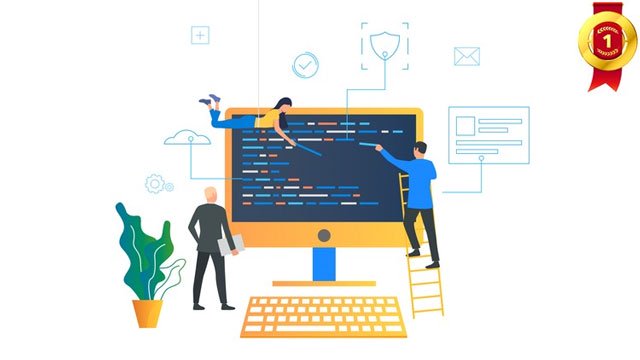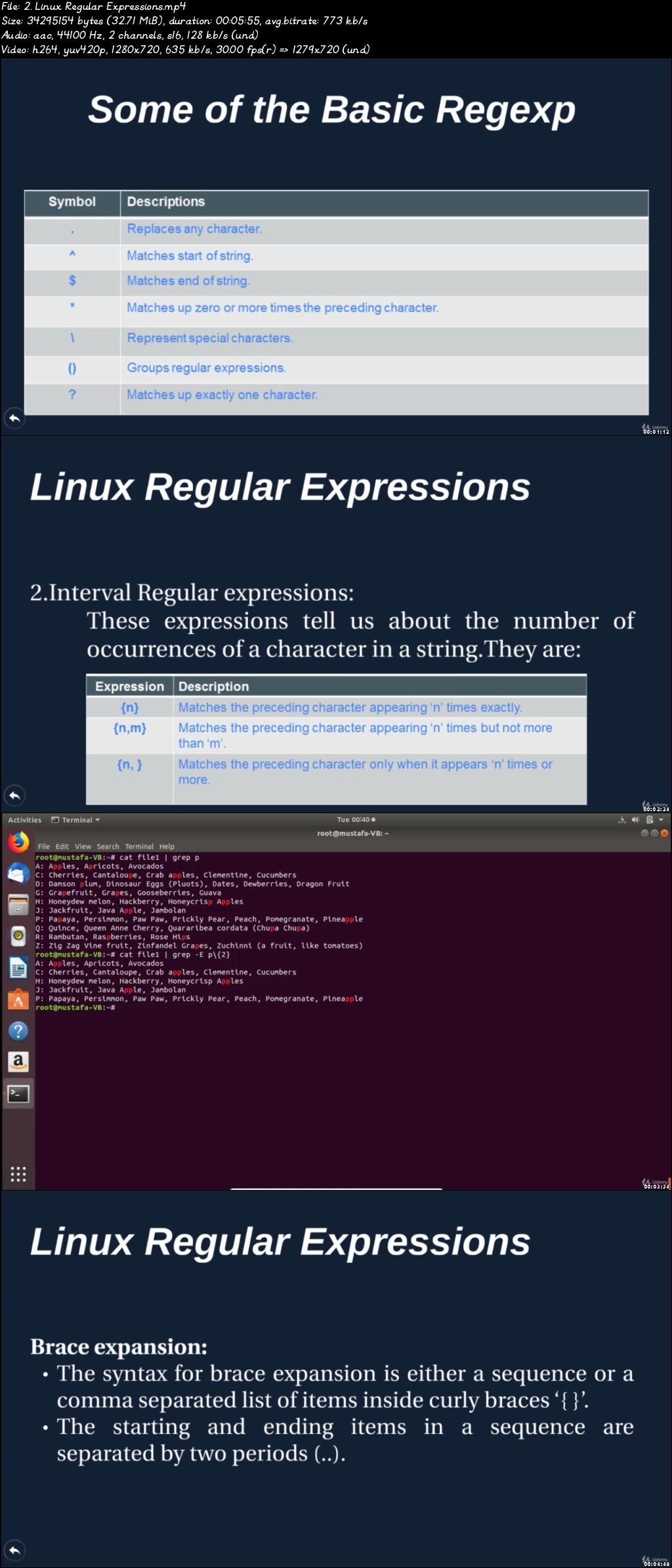
MP4 | Video: h264, 1280×720 | Audio: AAC, 44.1 KHz, 2 Ch
Genre: eLearning | Language: English + .srt | Duration: 94 lectures (3 hour, 31 mins) | Size: 1.25 GB
Join the Best Ubuntu Linux Operating System course for newbie Ubuntu Linux users!!
What you’ll learn
By the end of the course, you should have obtained enough information to easily install, run, and manage the Ubuntu Linux operating system.
You will learn the fundamentals/essential skills of the Ubuntu Linux operating system. Besides enjoying the features offered by the Ubuntu Linux OS.
You will Learn the Ubuntu Linux system administration basics and the most popular Ubuntu Linux commands.
Learn running and managing the Ubuntu Linux operating system professionally.
Be able to access the Ubuntu Linux operating system graphically and from the command line.
Learn accessing the Ubuntu Linux virtual consoles.
Learn the Ubuntu Linux shell basics.
Learn the Ubuntu Linux quick start commands.
Learn the Ubuntu Linux relative and absolute paths.
Learn the Ubuntu Linux shell special keys.
Learn the most important files and directories on the Ubuntu Linux operating system.
Learn the Ubuntu Linux command-line file management.
Learn the Ubuntu Linux I/O redirection.
Be able to get help in Linux graphically and command-line using different tools.
Requirements
There are No Requirements necessary to enrol, I only ask you to come Open-minded and Ready to Learn.
Description
JOIN THE BEST UBUNTU LINUX (SERVER/DESKTOP) OPERATING SYSTEM COURSE FOR NEWBIE LINUX USERS!!
Hi. My name is Mustafa and I’m the author of the ‘Ubuntu Linux’ course. I started working as a network and computer systems administrator since January 2011. I have a bachelor degree in engineering from Alexandria University. After finishing university, I concentrated on learning the Linux system administration. I have many certifications in Linux system administration, network administration, database administration, and some programming languages ‘C, C++, and Python’. I have a large experience in working on Linux using RHEL, CentOS, and Ubuntu Linux distributions. I have a desire to teach others and transfer my experience to them in an easy and simplified way.
A High Benefit Course to Learn the Ubuntu Linux Operating System Step by Step.
A Large Number of Ubuntu Linux Important Commands is Included in this Course.
The Course Include Quizzes on All Sections.
The Course is Manually Captioned.
The Course is Compressed to Achieve the Course Goal in a Short Time.
Course Content:
Background & Introduction.
Beginning with the introduction of the Ubuntu Operating System and mentioning its history.
What is an operating system?
The pieces that make up the operating system.
Ubuntu Pros & Cons.
Ubuntu Installation.
Ubuntu live distribution.
Creating a bootable Ubuntu USB stick from Microsoft Windows.
Trying Ubuntu without installing.
Introducing the VirtualBox program and showing the step by step procedure of downloading and installing it.
Creating a new Virtual machine for the Ubuntu OS.
Steps for downloading and installing the Ubuntu 18.04 OS.
Installing the VirtualBox Guest Additions.
Having a full-resolution Ubuntu VM on your computer.
Starting the Ubuntu OS.
Logging in and Logging out.
Introducing the Ubuntu OS.
Introducing the Shell or Terminal “the command line interface”.
Installing software on Ubuntu intro.
Steps for adding and removing applications from the Ubuntu OS Graphically and using the Command line.
The sudo command.
The apt-get command.
The apt-cache command.
Opening a list of your currently installed programs in terminal using the dpkg command.
The aptitude command.
The Ubuntu Software Center.
Installing and uninstalling software in Ubuntu using Debian package ‘dpkg’.
Manual download of a .deb (Debian package) method.
QuickStart.
The Linux system basic modes.
Ways of launching a terminal on Ubuntu.
Describing the command prompt in the terminal.
How to get into the text mode ‘virtual consoles’ and how to switch back to the graphical mode.
The Important Basic Commands of the Linux OS.
The pwd command.
The cd command.
The absolute path.
The relative path.
The ls command.
The passwd command.
The file command.
The cat command.
The exit command.
The Linux shell special keys.
Getting help in Linux.
The man command.
The info command.
The whatis command.
The which command.
The –help option.
The graphical help.
The gnome-help command.
The yelp command.
About Files and the File System.
The shell built-in commands.
Overview of the Linux File System.
The files types.
The file type signs.
What is the partition?
The kinds of major partitions on a Linux system.
The data partition.
The swap partition.
The important files and directories on the Linux operating system.
The standard root partition.
The swap space.
The /boot partition.
The /usr partition.
The /home partition.
The /var partition.
The /opt partition.
The mount points.
The df command.
Orientation in the file system.
The PATH environment variable.
The echo command.
Displaying and setting paths.
Adding a new directory to the PATH variable.
The export command.
The ( ~/.profile & ~/.bashrc ) files.
The source command.
The kernel.
The shell.
The shell types.
The sh or Bourne Shell.
The Bash or Bourne Again Shell.
The csh or C Shell.
The tcsh or Turbo C Shell.
The ksh or the Korn shell.
The file /etc/shells.
The SHELL variable.
The HOME variable.
Navigating through the Linux File System.
The /etc directory.
The /dev directory.
The /var directory.
The ls command popular options.
Creating, copying, moving and removing files and directories.
Finding files and paths.
The which command.
The find command.
The locate command.
Linking Files.
The hard link.
The soft link or symbolic link.
Creating a symbolic link.
The ln command.
Processes.
What is the process?
Multi-user and Multi-tasking Process Types.
Interactive and Automatic Processes.
Foreground process.
Background process.
The less command.
Job control.
The kill command.
Daemons.
Linux Pipe.
The pg command.
The more command.
The grep command.
The sort command.
Linux Filter.
Process Attributes.
The ps command.
Displaying Process.
The real group owner of a process (RGID).
The effective group owner of a process (EGID).
The SGID (Set Group ID upon execution).
The pstree command.
The top command.
How to Create a Process.
How to End a Process.
Linux Signals.
Showing signals list.
The common signals in Linux.
SIGTERM.
SIGINT.
SIGKILL.
SIGHUP.
SIGSTOP.
Reboot, halt, and shutdown commands.
Managing Processes.
The time command.
About system performance.
About system Load.
Managing process priority and niceness.
The nice command.
The renice command.
Managing Process CPU and Memory Resources.
The uptime command.
The memusage command.
The memusagestat command.
Tuning System Performance.
The vmstat command.
The netstat command.
The iostat command.
Network I/O problems.
Network integrity problems.
Disk I/O problems.
Users classes.
The graphical tools.
The Gnome System Monitor.
The xload application.
Interrupting processes.
The pidof command.
The xkill program.
Scheduling processes.
The sleep command.
The at command.
The Input and Output Redirection.
Linux Regular Expressions.
Basic regular expressions.
Interval Regular expressions.
Extended regular expressions.
Brace expansion.
Simple Redirections.
The redirection operators.
Input redirection.
Combining redirections.
The spell command.
The append operator.
The date command.
Advanced Redirections.
Use of file descriptors.
Separating standard output from standard error.
The tty command.
The tee command.
The uptime command.
Text Editors.
Importance of Text Editors.
The Easy Way to Learn the Vim Editor.
The vimtutor command.
Ubuntu Virtual Terminals.
What are virtual terminals?
Starting virtual terminals and navigating through them.
Virtual terminal shortcuts.
Ubuntu Linux Communication Utilities
The ping command.
The ftp command.
The telnet command.
The ssh command.
The Ubuntu System Administration Basics.
Creating a user using the terminal.
Creating a user using the GUI.
Deleting and disabling an account using the terminal.
Deleting and disabling an account using the GUI.
Adding a user to a usergroup.
Removing a user from a usergroup.
The gnome-system-tools.
The users-admin command.
The File Security in Terms of Ownership and Permissions.
Levels of authorization in Linux.
Ownership in Linux files.
Permissions.
The chmod command.
The chmod command absolute and symbolic modes.
Changing Ownership and Group.
The chown command.
The chgrp command.
The Bonus of the Course, Steps of installing ‘Qt Creator’ on Ubuntu OS.
###The Commands included in the course:
vim
vimtutor
man
info
whatis
apropos
cat
–help option
apt-get
sudo
dbkg
pr
lp
lpr
pwd
cd
ls
passwd
file
exit
touch
mkdir
rm
rmdir
mv
cp
grep
sort
find
ln
echo
jobs
bg
fg
kill
xkill
tty
tee
date
uptime
ps
pstree
top
nice
renice
vmstat
netstat
iostat
sleep
at
atq
atrm
nano
shutdown
ping
ftp
telnet
ssh
chmod
adduser
su
userdel
groupmod
usermod
deluser
chown
chgrp
groups
umask
ENROLL NOW AND ENJOY LEARNING THE UBUNTU LINUX FUNDAMENTALS / UBUNTU LINUX ESSENTIAL SKILLS!!
Who this course is for:
Anyone with a desire to learn Ubuntu Linux.
Anyone who needs to learn Ubuntu Linux for a personal or business project.
A newbie Linux user who wants to be professional in using Ubuntu Linux.
An existing Ubuntu Linux user who wants to increase his knowledge.
Anyone who wants to learn the basics of Ubuntu Linux system administration.
Windows or macOS users who want to switch to Ubuntu Linux.
Student testimonials:
Jonathan Hecl: Very useful and complete course.
Ghada Atef: It has been a wonderful experience. Mustafa is an amazing instructor. The contents and length of the course are just perfect to start working freely on Ubuntu. The course covers a wide variety of topics explained in a clear and simple way. I would highly recommend this course.
Who this course is for:
The Ideal student for this course is a newbie Linux user who wants to Learn how to run and manage the Ubuntu Linux operating system professionally in a short time.
A Current Linux user who wants to Increase his Knowledge.
May be interesting and useful for home users who want to learn more about the Linux operating system.

Password/解压密码-0daydown
Download rapidgator
https://rg.to/file/210a399632d67d9c9e258b420fcf5097/Ubuntu_Linux.part1.rar.html
https://rg.to/file/7af0c4a630e7a2481f1ba4bff30b753b/Ubuntu_Linux.part2.rar.html
Download nitroflare
https://nitroflare.com/view/C890B16F780CE2B/Ubuntu_Linux.part1.rar
https://nitroflare.com/view/3B9608C206CE309/Ubuntu_Linux.part2.rar
转载请注明:0daytown » Udemy: Ubuntu Linux